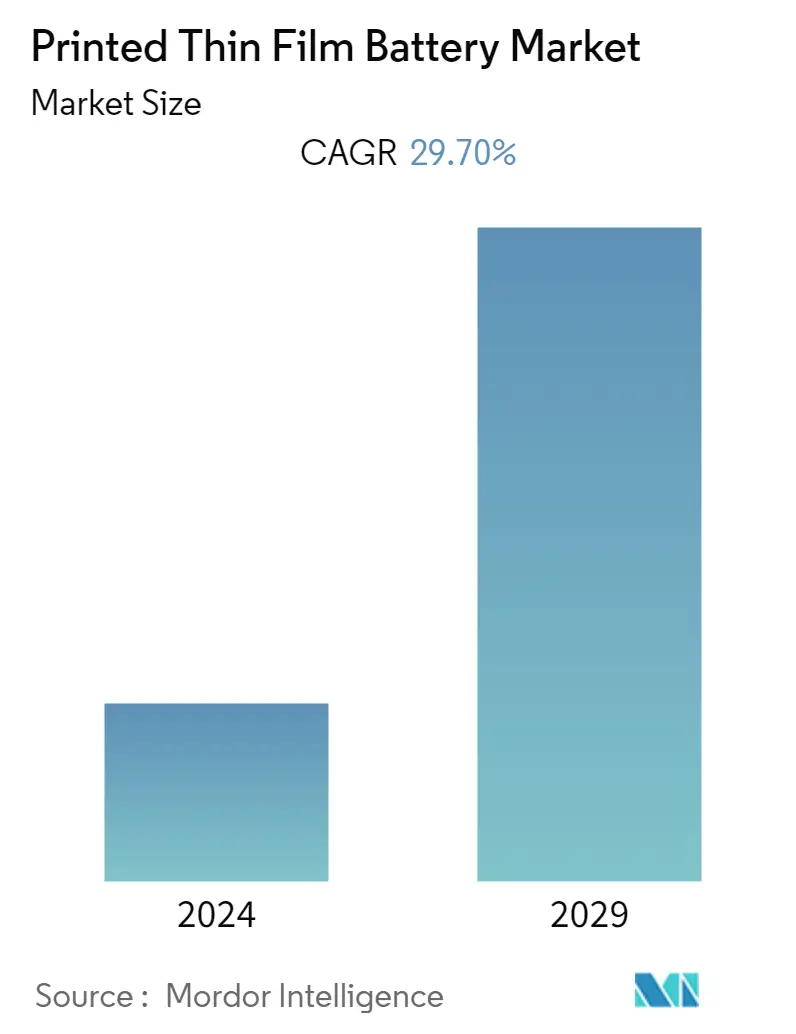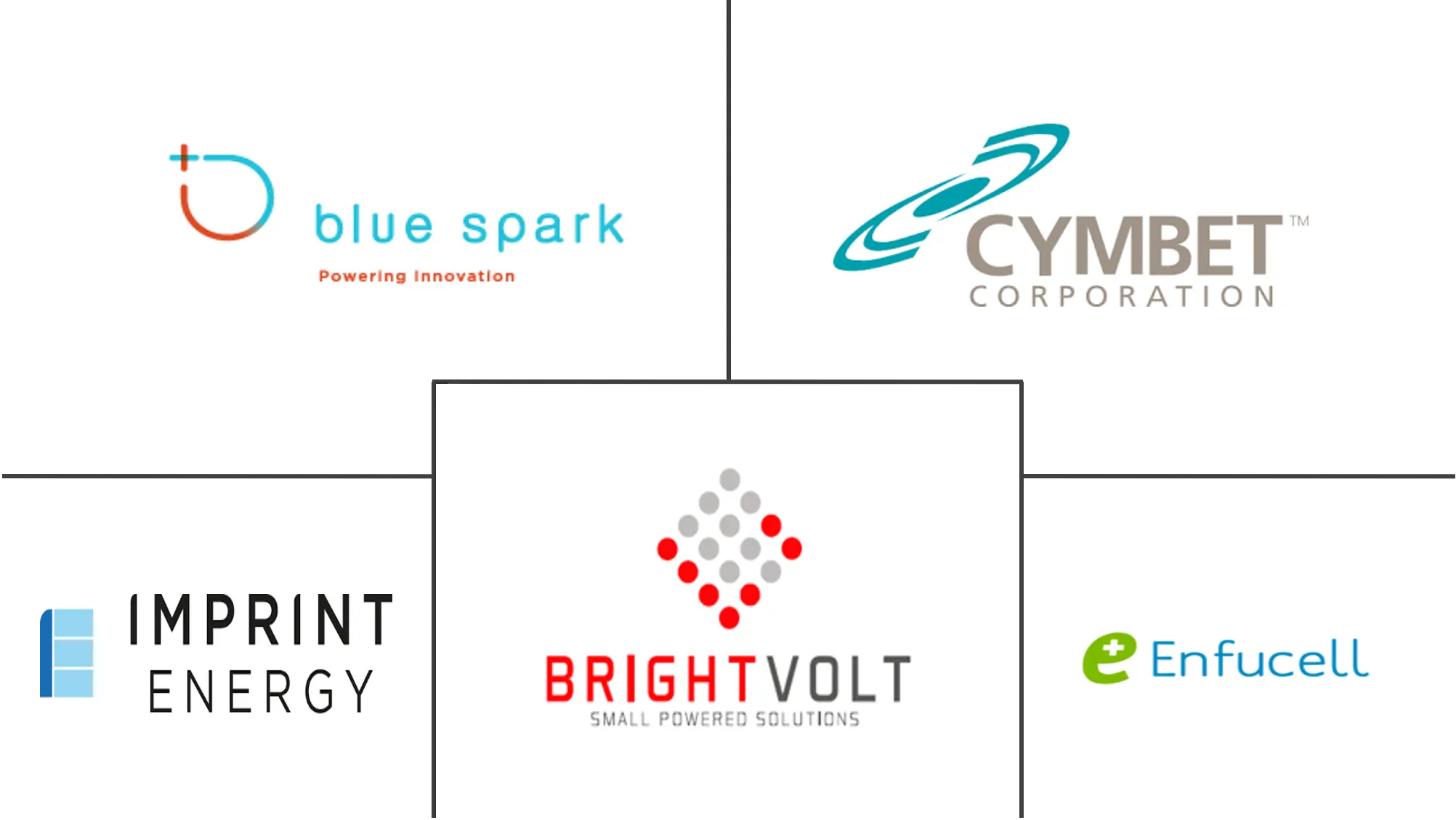Market Size of Printed Thin Film Battery Industry

| Study Period | 2019 - 2029 |
| Base Year For Estimation | 2023 |
| CAGR | 29.70 % |
| Fastest Growing Market | Asia Pacific |
| Largest Market | North America |
| Market Concentration | High |
Major Players
*Disclaimer: Major Players sorted in no particular order |
Printed Thin Film Battery Market Analysis
The Printed Thin Film Battery Market is expected to grow at a CAGR of 29.7% over the forecast period 2021 to 2026.
- Intrinsic properties of flexible, printed, and thin-film solid-state batteries include lighter weight, longer lifespan, high energy density, improved safety performance, and application in medical equipment, wearable devices, and smart cards, among others, are expected to drive their demand in the market.
- The growing demand for wearable devices is anticipated to provide potential growth landscape for printed thin-film battery market over the forecast period. Wearable devices such as smart clothing, smartwatches, and fitness bands incorporate thin film and flexible batteries due to their compact design and enhanced recharging rate.
- According to Cisco Systems, the number of connected wearable devices globally has more than doubled in three years, increasing from 325 million in 2016 to 722 million in 2019. The number of devices is projected to reach more than one billion by 2022.
- Key vendors in the market focus on innovation and technological advancements to deliver improved battery performance and grab maximum share of the market. For instance, Cymbet Corporation, in June 2019, introduced the next generation of Power Management with RTC (PMRTC) products, which integrates an ultra-low-power Real-Time Clock (RTC) with power management and power switching optimized for the innovative applications.
- Thin printed thin film batteries are the ideal solution for energy harvesting systems for their ultra-thin profile and low leakage characteristics. Increasing the adoption of energy harvesting-based autonomous wireless sensor nodes has created massive opportunities for thin film batteries as a power source. For the energy harvesting application, several companies are looking for flexible thin film batteries to power wireless sensors.
- Cost constraint and low energy density of currently available flexible thin film and printed batteries are some significant restraints for the market growth. However, growing demand for printed electronics, and a surge in rechargeable batteries are anticipated to generate potential opportunities for the flexible thin film and printed battery industry.
Printed Thin Film Battery Industry Segmentation
Printed thin-film batteries are batteries holding the property of flexibility. Flexibility is achieved by fabricating the conducting additives on a flexible substrate by using printing or chemical deposition techniques. Current collectors in flexible batteries are in the form of ink or thin metal foil.
| By Application | |
| Consumer Electronics | |
| Energy Harvesting | |
| Wearable Technology | |
| Smart Packaging | |
| Pharmaceutical & Medical Devices | |
| Smart Cards | |
| Other Applications |
| By Chargeability** | |
| Rechargeable | |
| Non-rechargeable |
| Geography | |
| North America | |
| Europe | |
| Asia-Pacific | |
| Rest of the World |
Printed Thin Film Battery Market Size Summary
The Printed Thin Film Battery Market is poised for significant growth, driven by the increasing demand for flexible, lightweight, and high-energy-density power sources. These batteries are particularly suited for applications in wearable devices, medical equipment, and smart cards due to their compact design and enhanced safety features. The surge in the adoption of wearable technology, such as smartwatches and fitness bands, is a key factor propelling market expansion. Companies are focusing on innovation and technological advancements to enhance battery performance, with major players like Cymbet Corporation introducing products that integrate advanced power management features. Despite challenges such as cost constraints and low energy density, the market is expected to benefit from the rising demand for printed electronics and rechargeable batteries.
In the Asia Pacific region, the market is experiencing robust growth due to the modernization of consumer electronics and the increasing popularity of wearable devices. The region's consumer electronics manufacturers are adopting thin power sources to align with the flexible designs of their products, further fueling market growth. The expanding electronic manufacturing industry in countries like China, India, Japan, and South Korea supports this trend. The market is highly concentrated with several key players, including Blue Spark Technologies and Imprint Energy, who are investing in research and development to enhance their market positions. Recent product innovations, such as Enfucell's Wearable Temperature Tag and Imprint Energy's ultrathin printed batteries, highlight the ongoing advancements in this sector.
Printed Thin Film Battery Market Size - Table of Contents
-
1. MARKET DYNAMICS
-
1.1 Market Overview
-
1.2 Marker Drivers
-
1.2.1 Growing Demand for Wearable Devices
-
1.2.2 Emerging Need for Mechanically Flexible, Lightweight, and Cost-effective Products
-
1.2.3 Increased Requirement for Thin Film and Printed Battery Solutions in Healthcare Industry
-
-
1.3 Market Restraints
-
1.3.1 Lack of Standardization in the Development of Thin Film and Printed Batteries
-
1.3.2 High Capital Requirement for R&D and Infrastructure
-
-
1.4 Market Opportunities
-
1.4.1 Vast Opportunity for Thin Film and Printed Batteries in Energy Harvesting Application
-
-
1.5 Industry Attractiveness - Porter's Five Forces Analysis
-
1.5.1 Bargaining Power of Suppliers
-
1.5.2 Bargaining Power of Buyers/Consumers
-
1.5.3 Threat of New Entrants
-
1.5.4 Threat of Substitute Products
-
1.5.5 Intensity of Competitive Rivalry
-
-
1.6 Industry Value Chain Analysis
-
1.7 Impact of COVID-19 on the Printed Thin Film Battery Market
-
-
2. MARKET SEGMENTATION
-
2.1 By Application
-
2.1.1 Consumer Electronics
-
2.1.2 Energy Harvesting
-
2.1.3 Wearable Technology
-
2.1.4 Smart Packaging
-
2.1.5 Pharmaceutical & Medical Devices
-
2.1.6 Smart Cards
-
2.1.7 Other Applications
-
-
2.2 By Chargeability**
-
2.2.1 Rechargeable
-
2.2.2 Non-rechargeable
-
-
2.3 Geography
-
2.3.1 North America
-
2.3.2 Europe
-
2.3.3 Asia-Pacific
-
2.3.4 Rest of the World
-
-
Printed Thin Film Battery Market Size FAQs
What is the current Printed Thin Film Battery Market size?
The Printed Thin Film Battery Market is projected to register a CAGR of 29.70% during the forecast period (2024-2029)
Who are the key players in Printed Thin Film Battery Market?
Blue Spark Technologies, Inc., Enfucell OY Ltd., Brightvolt Inc., Cymbet Corporation, Inc. and Imprint Energy, Inc. are the major companies operating in the Printed Thin Film Battery Market.

